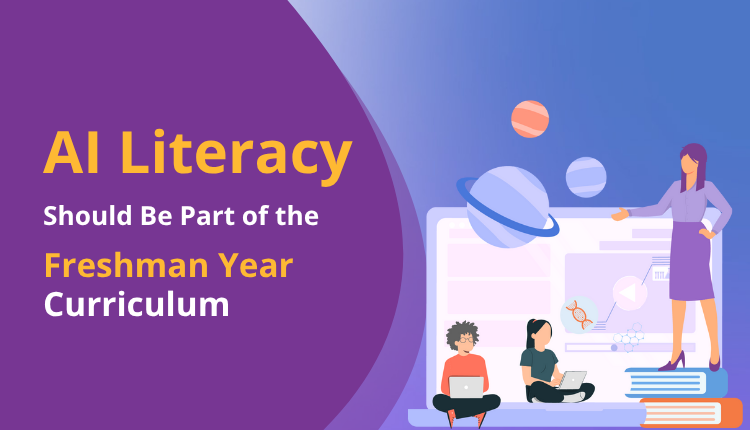AI Literacy Should Be Part of the Freshman Year Curriculum

Imagine two universities with identical rankings and resources. University A invests heavily in AI detection software, training faculty to be digital detectives, creating a climate of suspicion. University B, on the other hand, integrates AI literacy from the start, empowering students to be ethical AI collaborators and using transparent tools to improve learning. Fast forward three years. Which university’s graduates are leading the way in innovation? Which one attracts top talent? The answer is clear and rooted in workforce realities, with the World Economic Forum highlighting that AI skills now outweigh job experience. Two-thirds of business leaders won’t hire candidates without AI skills, and nearly three-quarters prefer less experienced candidates with AI competencies over seasoned ones without them. This shift means that graduates without basic AI skills will enter a workforce that increasingly demands them.
Table of Contents
ToggleAI Literacy: A Necessity Today
So, what exactly is AI literacy? It goes beyond technical skills; it’s a broad set of competencies that enables individuals to critically assess AI technologies, work with AI effectively, and use it as a tool in various contexts, from online to at home to in the workplace. At its core, AI literacy focuses on understanding how AI systems function, their proper use, evaluating their outputs, and recognizing their limitations and risks. Research shows that AI literacy enhances student engagement, improves critical thinking, prepares them for AI-driven careers, and fosters better ethical reasoning about technology in an evolving world.
It’s important to differentiate AI literacy from simply using AI tools. A study of 666 participants found that frequent use of AI tools without proper literacy actually harms critical thinking. The takeaway is clear—structured AI literacy, not unregulated AI access, is what shapes capable professionals.
The Flawed “Detection-First” Approach and Its Hidden Costs
Despite the growing need to embed AI literacy, most institutions remain stuck in a “detection-first” mindset, viewing AI as a threat rather than a transformative tool. This approach carries hidden costs across all levels of academia. AI detection tools for text have significant flaws, making them unsuitable for critical academic decisions. Research shows they are unreliable, prone to false positives and false negatives. These tools perform even worse when texts are edited or paraphrased—common practices that make detection nearly impossible. The reality is that AI detection tools should not be the sole basis for accusing students of academic misconduct, but many institutions continue to rely on them due to a lack of better alternatives.
Shifting to Outcome-Focused Education
The most successful institutions are shifting from input-focused to outcome-focused education. Instead of asking, “How was this work created?” they ask, “What did the student learn, and how can we help them learn more?” Institutions should harness AI’s potential to personalize learning at scale, identify gaps, predict outcomes, and suggest tailored learning paths. This shifts educators from being compliance officers to becoming learning architects.
Transparency Is Key
The future doesn’t lie in banning AI or allowing unregulated use—it lies in transparency. Clear documentation of how AI contributes to the learning process will be crucial. Imagine students showing their learning journey in real time, explaining how they engaged with AI, what they learned, and how they applied critical thinking to AI outputs. This approach builds trust and maintains academic integrity.
DocuMark: Making Transparent Learning a Reality
Trinka’s DocuMark empowers institutions to embrace AI literacy with transparency and accountability. It offers:
-
Real-time AI usage documentation: Students’ use of AI tools in their assignments is automatically tracked, promoting responsible AI usage.
-
Clear attribution of AI contributions: DocuMark differentiates between student-written and AI-assisted text, allowing faculty to see what was generated or refined by AI.
-
Evidence of critical thinking: Students can provide reflections on why they used AI, how they evaluated its output, and how it informed their learning.
-
Streamlined academic integrity workflows: Faculty receive comprehensive AI usage reports, reducing the burden of manually detecting and investigating suspected cases.
-
Equity and fairness in assessments: Transparent documentation ensures students are evaluated based on their learning, not penalized for unreliable AI detection results.
-
Compliance with institutional policies: DocuMark helps institutions align with evolving AI guidelines, creating clear standards without fostering a culture of fear.
In a world where AI literacy is critical for future-ready graduates, DocuMark bridges the gap between responsible AI usage and academic integrity, positioning institutions as leaders in ethical, innovative education.
Act Now to Shape the Future!
Universities that integrate AI literacy from day one is not just preparing students for the future—they are shaping it. These institutions:
-
Attract top students seeking forward-thinking education
-
Recruit innovative faculty who focus on teaching, not policing
-
Partner with leading organizations that value AI-literate graduates
-
Lead research in AI-human collaboration
-
Influence policy and practice
Ready to transform your institution from a culture of detection to one of development? Discover how DocuMark can help you build transparent, outcome-focused learning that prepares students for an AI-driven future.
Book your free demo today and join the educational leaders already shaping tomorrow.




